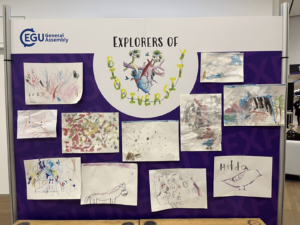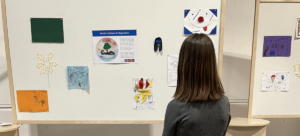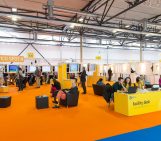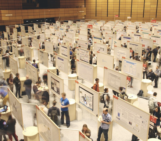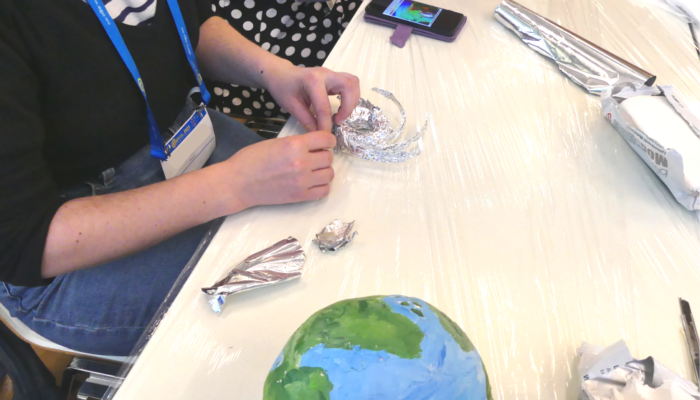
At EGU we take our science seriously, but we also value creativity and the role it plays in all aspects of being a researcher, from designing your study to science communication! The EGU25 General Assembly offers plenty of avenues for creativity in every way, shape and form! If you’re keen to indulge your creative side or curious about the possible intersections between science and art, look no further.
This blog lists some of our unique (and highly anticipated) creativity-based sessions at EGU25. So browse through and make sure to add at least a few of these to your personal programme!
EGU25 Photo Competition: vote for your favourite!
Each year EGU runs a photo competition for attendees of the General Assembly shortlisted into the top 10 submissions. These submissions are then open for you to vote on, to select the top three winning photos, with the winners announced on the Friday of the meeting! Voting will open on Sunday 27 April, so watch out for the shortlist announcement next Monday! For more information, visit the EGU Photo Competition page on Imaggeo. You can also check out all of the 2010 to 2021 winners here.
Sessions
If you are interested in how art and science can be used as a part of research don’t miss out on the two sessions dedicated to the interaction of art and sceince at a research level, through creative approaches in EOS1.2 Exploring the Art-Science Interface on Wed, 30 Apr, 08:30–12:25 (CEST) and 14:00–15:40 (CEST) in room -2.41/42 (Purple level) and by looking at how games can be used in scientific work and communication in EOS1.3 Games for Geoscience on Wed, 30 Apr, 14:00–15:45 (CEST) for posters in Hall X2 and 16:15–18:00 (CEST) in room -2.41/42 (Purple level).
Find more art-science related sessions by using the Art-Science tab in the ‘Sessions of special interest’ section of the EGU25 Programme!
Short courses
As a scientist, you may be immensely passionate about your research abstract, but how can you share this in new and exciting ways? Why not let these short courses give you some creative inspiration!
SC 3.1 Introduction to Improvisational Theatre and How It Can Help You and Your Science Fri, 02 May, 10:45–12:30 (CEST)
Room -2.82 (Purple level)
Have you ever thought about improvising in your research? It might sound surprising, but the skills from improvisational theatre (improv) can offer exciting ways to approach science. This Short Course, will introduce you to the world of improv, an art form in which performers create a scene that is barely or completely unplanned with no written dialogue, and demonstrate it’s many benefits, including to neuroplasticity, emotional intelligence, collaborative and interactive pedagogy, self-confidence, imagination and creativity.
SC 3.6 Draw them in: communicating your research through illustration Mon, 28 Apr, 08:30–10:15 (CEST)
Room -2.82 (Purple level)
From graphical abstracts to illustrated magazine covers to online article banners… eye-catching graphics open many doors when it comes to successfully communicating science, both inside and (particularly) outside specialist circles. So, if visuals play such a significant role in drawing audiences in, why don’t more scientists utilise illustration as a way to break the barrier between them and the public? For many, the answer simply is “I can’t really draw”. But what if you could? Using principles and examples from stylized illustration, this hands-on short course will guide you through the process of creating a scientific illustration from start to finish, and prove to you that you can, in fact, draw. If you wish to, you will be able to use the last part of the course to work on your first scientific illustration, inspired by a piece of work chosen by you. Whilst I am a digital illustrator, you may choose any media to work with, this is not a course for learning how to draw with pixels!
SC 5.1 Unlocking creativity through paper sculptures: Overcoming blocks in writing and idea generation (onsite only) with EGU25 Artist in Residence Liliane Burkhard Fri, 02 May, 10:45–12:30 (CEST)
Room 0.55 (Yellow level)
In this interactive short course, participants will explore how the art of paper folding and sculpture can serve as a powerful tool to overcome creative blocks and reignite inspiration. Whether struggling with writer’s block, a lack of ideas, or the pressure to innovate, this hands-on
workshop demonstrates how engaging in tactile, meditative processes like origami and paper sculpture can unlock new ways of thinking. Using simple materials and techniques, attendees will learn to create unique paper forms that encourage mindfulness, focus, and the flow of fresh ideas. The course will also highlight the parallels between the iterative process of folding and the journey of idea development in
scientific research, emphasizing the importance of experimentation, flexibility, and patience.
SC 5.2 Scientific worldbuilding: create your own scientific fantasy map (onsite only) with EGU25 Artist in Residence Annabelle Foster, Fri, 02 May, 14:00–15:50 (CEST)
Room 0.55 (Yellow level)
Maps are used in Sci-Fi and Fantasy books for world-building and adding perspective to a story. A lot of thought goes into their creation to help readers visualise how a character goes from point A to B. Famous examples include Tolkien’s map of Middle Earth in Lord of the Rings, George R. R. Martin’s Westeros in Game of Thrones, Robert Louis Stevenson’s Treasure Island and C. S. Lewis’ Narnia. Most of us have read books – or been in the audience during a scientific talk – and felt lost within a sprawling story, but maps help to forge an immersive experience. This workshop aims to merge the fictional story world with science. During the workshop, we will be creating our own fantasy-style maps that relates to our scientific research. You will be guided, step by step, through hand drawing geographical features, settlements, or anything else that you’d like on your map. At the end of this workshop, you will have a unique and beautiful map of your research to decorate your offices with!
Children’s Art Gallery
As a part of our free childcare service, even the kids at EGU25 get involved in art-science! Set up near the entrance of Hall X1, don’t miss the growing gallery of art created at EGU25 by our very early career scientists! Each year we have a theme to help guide our young artists, this year the theme is: Power from the Planet, inspired by our Energy, Resources and Environment (ERE) Division, exploring renewable energy sources such as solar, wind, and geothermal.
Any kids in the conference center can take part, whether you are using the unsupervised family rooms or the childcare facilities, if you want to share the work of your kids, of various ages and talents, hand in your art-science submissions to the childcare reception desk to be displayed on the board!
Artist Raising Awareness of EDI
Roser Cussó Located in Hall X2, booth #X206 (beside EDI com)
Project called “Augmented Ecofeminisms: Climate, Water, Women
Augmented ecofeminisms: climate, water and woman”. The art project invites reflection on the effects of climate change on freshwater ecosystems and their interaction with women. Through a journey that combines augmented reality with scientific, plastic and audiovisual material, the project questions the current management of environmental problems related to water; and explore potential futures based on alternative views to contemporary politics and from an ecofeminist perspective.
EGUart: celebrate new forms of science communication
One of the many highlights of EGU’s General Assembly is the annual Artist in Residence programme. It offers scientist-artists an opportunity to engage with scientific research in a dynamic setting and be inspired by the many new discoveries presented at the conference. This year our two Artists in Residence are Liliane Burkhard, a sculptural mixed media artist and planetary geologist from Switzerland, and Annabelle Foster, an illustrator and volcanologist from the UK – why not reach out to them to discuss possible collaboration during the week?! They will be available to attendees who are participating both on-site and virtually, so there is nothing stopping you from making a connection with them! EGU25 participants will be able to see images of the artwork produced by artists via our official social media channels (using the hashtag #EGUart), on the EGU GeoLog blog and live at the conference centre. If you’re curious about the last few years’ Artists in and (not) in Residence, visit our Youtube playlist and EGU’s GeoLog blogs.
We hope this list has inspired you to add some of these creative options when you plan your EGU25 conference experience. More detailed information on each of these events will be shared in upcoming blog posts, closer to the meeting. If you wish to browse through other sessions, we recommend a visit to the EGU25 Programme page. Choose “Please Select” and then pick your category of interest on the session programme page.

